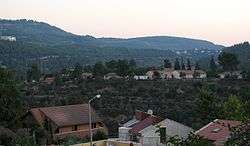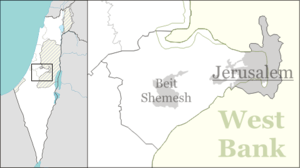Beit Zayit
| Beit Zayit | |
|---|---|
 | |
 Beit Zayit | |
| Coordinates: 31°46′57.67″N 35°9′33.62″E / 31.7826861°N 35.1593389°ECoordinates: 31°46′57.67″N 35°9′33.62″E / 31.7826861°N 35.1593389°E | |
| District | Jerusalem |
| Council | Mateh Yehuda |
| Affiliation | Moshavim Movement |
| Founded | 1949 |
| Founded by | Jewish immigrants from Hungary, Romania and Yugoslavia |
| Population (2015)[1] | 1,631 |
| Website | www.beit-zait.org |
Beit Zayit (Hebrew: בֵּית זַיִת, lit. House of Olives) is a moshav in Israel. Located just outside the Jerusalem municipal border to the west, it falls under the jurisdiction of Mateh Yehuda Regional Council. In 2015 it had a population of 1,631.
Beit Zayit lies on the edge of the Jerusalem Forest and operates a public swimming pool. Nearby is the Ein Kerem dam, built to store winter flood waters.[2]
History
A village named Beit Zayit is mentioned in the book of the Maccabees, but it is believed to have been further north, possibly at the site of the Palestinian Christian town of Bir Zeit, north of Ramallah.[2]
The modern village was established in 1949 by Jewish immigrants from Yugoslavia, Romania and Hungary. Later immigrants from Yemen and Egypt also settled in the village. The economy was based on fruit orchards, vegetables, poultry and other farm products.[2]
With the expansion of the moshav in the late 1990s, including the purchase of land by newcomers and renovation of old homes, Beit Zayit became a trendy alternative to living in Jerusalem.[3]
Dinosaur Footprints
In 1962 Dinosaur footprints were discovered in the garden of one of Beit Zayit's residents. The footprints probably belonged to a Struthiomimus,[4] and are on display at the Hebrew University of Jerusalem.[5] This is the only place in Israel where evidence of dinosaurs was discovered, and one of few such sites in the Middle East.[6]
References
- ↑ "List of localities, in Alphabetical order" (PDF). Israel Central Bureau of Statistics. Retrieved 16 October 2016.
- 1 2 3 Beit Zayit Jewish Virtual Library
- ↑ Posh Israeli suburb grows out of a farming co-op The New York Times, 2 January 2009
- ↑ Norman Ali Bassam Ali Taher Khalaf-von Jaffa (2006) Ornithomimid Dinosaur Tracks from Beit Zeit, West of Jerusalem, Palestine Gazelle: The Palestinian Biological Bulletin. Number 56, August 2006. pp. 1–7.
- ↑ Barbara Sofer (1995) Kids love Israel, Israel loves kids: a travel guide for families Kar-Ben Publishing, p103
- ↑ Feinberg Vamosh, Miriam. "Way Before the Flood: Dinosaur Tracks by Jerusalem". www.haaretz.com. Haaretz. Retrieved 6 April 2016.
External links
- Village website (Hebrew)